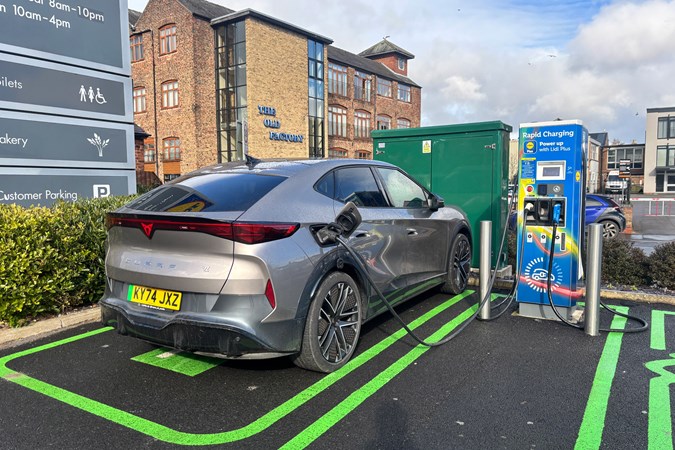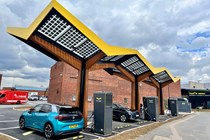New figures from Zap-map reveal that 136 new charging hubs, defined as sites with six or more rapid or ultra-rapid chargers, were installed in the first half of 2025. That brings the UK total to 673 hubs, underlining how much effort is going into improving long-distance journeys by electric car.
These hubs are increasingly popular among EV drivers who need quick, reliable charging on longer trips. Zapmap says they’re also shaping the future of electric car infrastructure, offering not just faster charge times but also better locations with facilities like cafes, toilets, and sustainable energy sources.
More chargers, and they’re getting quicker
Across the board, 8,670 new chargepoints were added in the first half of 2025, a 27% increase on the same period last year. There are now 82,369 public charging devices in the UK, spread across more than 40,000 locations.
Ultra-rapid chargers (150kW+) are growing fastest of all. Their numbers have risen nearly 23% so far this year to 8,619 devices, and for the first time, there are now more ultra-rapid chargers than the older, slower ‘rapid’ ones.
Here’s how the different charger types stack up:
| Power rating | June 2024 | Dec 2024 | June 2025 | YoY growth | YTD growth |
|---|---|---|---|---|---|
| Slow / Fast (<50kW) | 52,224 | 59,228 | 65,671 | 25.75% | 10.88% |
| Rapid (50-149kW) | 7,135 | 7,450 | 8,079 | 13.21% | 8.44% |
| Ultra-rapid (150kW+) | 5,416 | 7,021 | 8,619 | 59.14% | 22.76% |
| Charging hubs | 386 | 537 | 673 | 74.35% | 25.33% |
| Total | 64,775 | 73,699 | 82,369 | 27.16% | 11.76% |
On-street chargers catching up
Lower-powered chargers (under 50kW) still make up the majority of the network. They’re used mainly for topping up while parked or overnight charging, especially on-street where drivers don’t have private driveways.
There are now 29,227 on-street charge points across the UK. London still dominates with more than 20,000 devices, but other regions are catching up. In the first half of 2025, the rest of the UK saw a 25% increase in on-street chargers, which is a faster growth rate than in the capital.
This growth is partly thanks to government funding through schemes like LEVI (Local Electric Vehicle Infrastructure) and the earlier ORCS (On-Street Residential Charging Scheme), which are helping councils install more chargers close to homes.

Regional hotspots for charger growth
Some parts of the UK are seeing particularly rapid expansion. The North East saw a 40% increase in chargers across all power levels, while the East of England and West Midlands weren’t far behind with 39% and 38% growth respectively. Scotland, too, is forging ahead with a 29% increase in high-powered chargers.
Jade Edwards, head of insights at Zapmap, said: ‘The EV landscape at the mid-point of 2025 looks significantly different to six months ago, in terms of the shape of the infrastructure, EV demand and availability and the legislative landscape.’
She added that government support is increasingly helping drivers without off-street parking, giving them more practical ways to go electric.
What this means for you
For drivers, the growth in charging hubs and ultra-rapid chargers is great news if you regularly travel long distances. It means shorter queues, faster charging times, and less anxiety about finding somewhere to plug in when you’re away from home.
On-street charging is also finally picking up outside London, which is crucial for the many drivers who don’t have private driveways or garages. If you rely on public charging near home, this could make running an EV far more practical.
However, one big issue remains: cost. Rapid and ultra-rapid charging is often significantly more expensive than charging at home. If you’re considering an EV, it’s worth doing the maths to check how much you’d rely on public charging and how that might affect your running costs.
Editor’s view: Good news, but watch the costs
I’m optimistic about what these figures mean for drivers, especially those who regularly do longer trips. More hubs and faster chargers should make EV ownership a lot less stressful on the motorway. But there’s still work to do. We badly need more on-street chargers so that drivers without driveways aren’t left behind in the electric car transition.
And while more chargers are great, the price has to be right. Rapid charging in the UK is still too expensive for many. I’d love to see a French-style sliding scale adopted here, where the faster the charger, the higher the cost per kWh, but with fair pricing so drivers don’t feel punished for using public infrastructure.
If we can crack that, the EV future looks brighter than ever.
Keith Adams – Parkers Editor
For all the latest advice, news and finance deals, sign up to the Parkers newsletter here.
Just so you know, we may receive a commission or other compensation from the links on this website - read why you should trust us.




